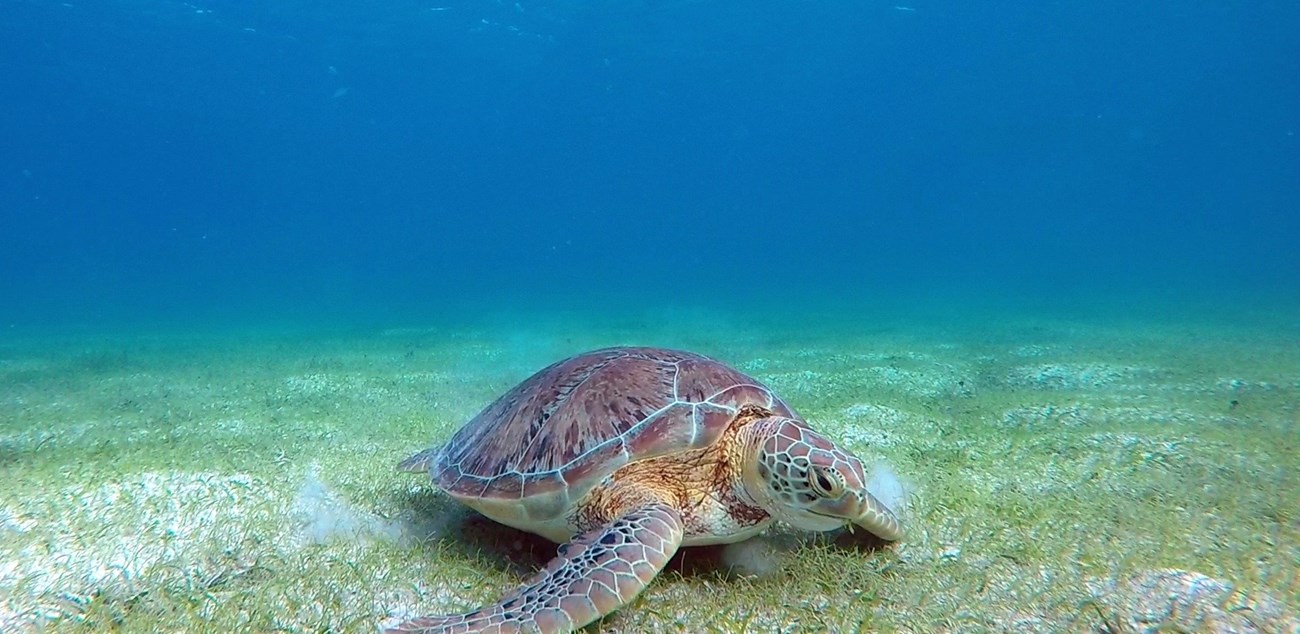Last updated: February 14, 2023
Article
Why Sea Turtles Returned to Buck Island
Beneath the turquoise waves of a Caribbean “gem,” we are witnessing the comeback of some of the world’s oldest animals.

Image © Matthew Warham
Your perception of Buck Island Reef National Monument changes at dusk. The views of the beach and crystal clear turquoise waters disappear in the darkness.
Instead, the sounds of the island fill your ears. Waves crashing on the coral stone cobbles. Ghost crabs scurrying about, dodging your footsteps. The leaves of the beach forest trees blowing in the wind. But then you hear something else. The sound of sand being tossed about in every direction and the smell of freshly exposed soil overwhelm your senses. You continue walking slowly toward the sound, using a red filter flashlight to guide your way. Then you see it and suddenly stop in your tracks. Below the low-hanging branches of a sea grape bush is one of the world’s oldest and most critically endangered animals. She is digging a nest chamber for her eggs. A hawksbill turtle.
Globally, sea turtle populations have declined by at least 95 percent since the fifteenth century because of severe overexploitation by humans. These prehistoric, charismatic animals are now mere relics of what they once were in our oceans. But in some U.S. national parks, the work of dedicated scientists is paying off, and sea turtles are making a comeback.

Image credit: NPS / Alexandra Gulick
A Caribbean Gem
Buck Island Reef National Monument is a marine protected area off the coast of St. Croix, U.S. Virgin Islands. Managed by Christiansted National Historic Site, it is one of the few national parks in the U.S. that is almost entirely underwater. Known as a “Caribbean gem,” the park has incredible biodiversity, supporting several threatened or endangered species and marine ecosystems. You will find coral reefs, seagrass meadows, deep-water habitats, coastal beaches, and tropical dry forests there. Buck Island is also well known for prividing critical habitat to sea turtles species, including the hawksbill turtle and the green turtle.
A hallmark of National Park Service natural resource management at Buck Island is the park’s sea turtle research program. The program uses saturation tagging (all nesting females encountered are tagged) and long-term monitoring to evaluate the status of sea turtle populations in the park. Since its establishment in 1987, the nesting population of endangered hawksbills has made a dramatic recovery, going from 12 females to over 500. For a species that takes 25–30 years to reach maturity, that’s a major comeback! The park’s green turtle population is also rebounding.
A World-Class Resource
The Buck Island Sea Turtle Research Program is one of the longest-running sea turtle programs in the world. Over three decades of monitoring and innovative research have placed the program at the forefront of sea turtle conservation. The program’s longevity and rigorous data collection methods provide managers with information that is priceless for assessing the status of sea turtle populations. Because sea turtles live so long (about 80 years), monitoring programs have to be able to collect data over at least two to three decades to give good guidance about the status of turtle populations. Very few programs worldwide have been able to generate datasets comparable to that of Buck Island’s.
Information collected by the park’s program plays a critical role in determining federal management strategies for hawksbill turtles in the Caribbean and Western Atlantic. The program’s framework and methods serve as a model for effective sea turtle monitoring. It has aided other parks like Dry Tortugas National Park and Virgin Islands National Park establish their own programs. The program conducts innovative research in partnership with federal (e.g., U.S. Geological Survey), academic, and nonprofit organizations. Through these avenues, the park has contributed novel work in the field of sea turtle biology and conservation.
A Conservation Success Story—with Challenges to Come
Although the establishment of the park’s long-term monitoring program was critical to the hawksbill’s remarkable return, other actions were also important. According to Zandy Hillis-Starr, Christiansted’s retired chief of resource management and the founder of the sea turtle research program, “Sea turtle nesting at Buck Island National Monument was few and far between in the 1970s and 1980s. Those females that were able to nest were up against poaching by humans, and nests were often predated by the invasive mongoose.” To address those concerns, the park successfully eradicated invasive predators from the island and increased ranger patrols, which helped eliminate poaching.
The park also reached out to people who lived in the local community to help raise awareness of the plight of sea turtles at Buck Island. Through seminars and outreach at local schools, the park sparked interest in sea turtles among community members and garnered their support. Today, numerous local students and community volunteers are actively involved with the park’s sea turtle program. Volunteers play a critical role in inspiring future generations of park managers and visitors.
"Hatchlings off the beach was always the goal, and we have succeeded."
Despite the significant conservation achievement of the hawksbill’s return, the story does not end there. Our recent population assessment showed that the annual number of nesting females has stabilized over the last decade, but the number of nests has declined. Female body size and clutch size (the number of eggs per nest) have also declined. Although smaller nesting females produce fewer eggs, this has not had a negative impact on hawksbill nest success or the number of hatchlings produced each year. This can be partially attributed to effective nest relocation practices that are included in the park’s monitoring protocol.
What do these results mean for the hawksbill turtle management plan? For one thing, change in female or nest abundance and decrease in body size can be early warning signs of declining growth rates, reproduction, and survival. But we cannot confirm such a decline for the Buck Island population without further research and monitoring.
We must also consider the effect of climate change on sea turtle populations in the context of park resources. Warming seas, sea level rise, and increased storm frequency affect sea turtle populations worldwide. Several climate-driven factors could threaten the hawksbill population at Buck Island: hawksbill foraging habitat (coral reef) degradation, higher nest temperatures that cause production of more female than male hatchlings, and changing shoreline dynamics due to rising sea levels and increased storm frequency. The latter could contribute to females nesting more frequently beyond the park boundary, outside of its protection.
Our research led us to recommend the following steps for managing the hawksbill nesting population at Buck Island:
- Evaluate trends in population demographics to diagnose the factors behind changes in abundance (the number of females and nests). For example, changes in female growth rates, survivorship, clutch frequency (number of nests laid per season), and aging of females can give clues for why changes in abundance occur.
- Assess the impacts of changing shoreline dynamics on hawksbill nesting activity. Pay special attention to the availability and quality of beach forest habitat (the preferred nesting environment for hawksbills).
- Increase outreach efforts to raise people’s awareness of hawksbill nesting activity beyond the park boundary and on the developed beaches of neighboring St. Croix.
- Continue the long-term monitoring and saturation tagging program. The recommendations above would not be possible without the program’s rigorous data collection.
Climate change threatens sea turtle populations globally. Buck Island’s status as an index site is critical to the survival of these endangered animals that are so dear to park visitors. As Zandy Hillis-Starr said, “The Buck Island Sea Turtle Research Program established a presence on these critical nesting beaches, providing protection for the few remaining long-term re-migrants and their nests. Today, after over 30 years of management efforts, several hundred individuals continue to nest at Buck Island, putting over 20,000 hatchlings out to sea. Hatchlings off the beach was always the goal, and we have succeeded.”

Image © Our World Underwater Scholarship Society / Shaun Wolfe
The Significance of Seagrass
Green turtles are recovering worldwide as a result of long-term conservation efforts. But green turtles primarily eat seagrass, and seagrasses are declining globally due to coastal development, degraded water quality, ocean acidification, and increasing temperatures. This has raised concerns about the ability of these systems to support increased grazing pressure by rebounding green turtle populations. Seagrass meadows at Buck Island provide food for juvenile and adult green turtles throughout the year. The increase in the park’s green turtle population prompted park managers to collaborate with scientists from the University of Florida’s Archie Carr Center to evaluate green turtle grazing dynamics and the effects of grazing on seagrasses at Buck Island.
This study revealed that green turtle grazing plays an important role in regulating the productivity of seagrass ecosystems and that increased grazing pressure actually stimulates seagrass growth. In addition, the center’s scientists identified a threshold for the amount of seagrass needed to sustain consistent grazing pressure by green turtles. Their results are helping create effective seagrass management strategies at Buck Island and other parks.
We recommend that park managers establish (or maintain) long-term seagrass monitoring programs. To be effective, monitoring protocols should incorporate appropriate metrics that account for the effects of green turtle grazing. We also encourage using an ecosystem-based approach to evaluate the interactions between sea turtles and their foraging environments. This will be useful when developing management plans.

Image credit: NPS
We Can’t Do It Alone
The success of the Buck Island Sea Turtle Research Program would not be possible without support from the local community on St. Croix. It is vital for our resource managers and scientists to share the success of our projects broadly. The National Park Service offers several opportunities for students to gain experience in science and resource management while supporting the sea turtle program. For example, the park offers multiple internships each year for students from diverse backgrounds to assist with field data collection and project outreach efforts.
These internships are offered through the Mosaics in Science and Diversity program and the Student Conservation Experience. We also work with park concessionaires to provide education and outreach to local school groups and tourists that visit the park. More recently, we began offering workshops to train local volunteers interested in monitoring St. Croix beaches for sea turtle nesting activity. This initiative was led by a student from the Scientists in Parks Fellows program. It will help monitor the spillover of sea turtle nesting beyond the park boundary.
We cannot do this alone. We need the ongoing support of collaborators and the local community to ensure the long-term success of sea turtle conservation in our national parks.
About the authors

Alexandra Gulick is a PhD Candidate in Zoology at the University of Florida. What happens when endangered species recover into ecosystems that have been degraded by human activity? How should resource managers and scientists prepare the public for the impacts of species recovery on ecosystem services? These two questions are the core of Alexandra’s interests as an aspiring marine ecologist and resource manager. Her doctoral research focuses on the grazing dynamics and foraging behavior of recovering green turtle populations in Caribbean seagrass ecosystems. Photo credit: NPS

Kristen Ewen is a National Park Service biologist and park dive officer for Christiansted National Historic Site in St. Croix, U.S. Virgin Islands. A part of her job that she really enjoys is having volunteers, especially young student groups, join NPS staff on resource management projects. She believes the future of our oceans depend on connecting the next generation with the knowledge and experiences that will ignite a lifelong passion for preserving this fragile ecosystem. Photo credit: NPS
